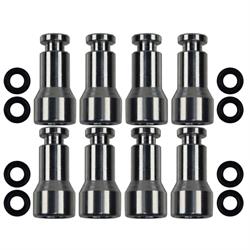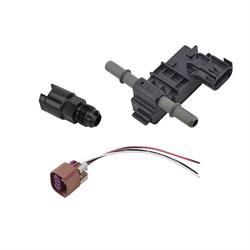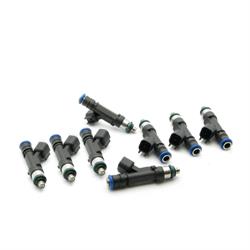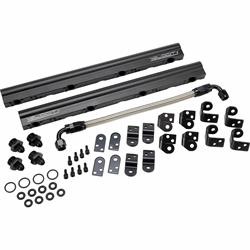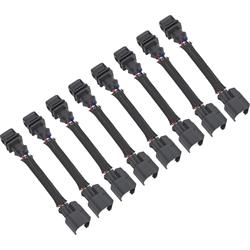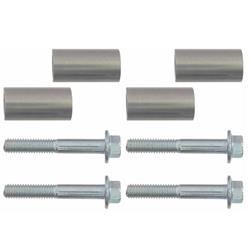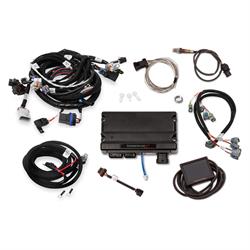What is The Best Fuel Injector For LS? Stock, Aftermarket, Decapped LS Injectors Explained
The LS platform is widely considered one of the most versatile modern engines since the small-block Chevy era. It’s known for its availability of parts, impressive horsepower potential, and affordability compared to other modern engines. It's no wonder this bow-tie powerplant is being used in cruisers, hot rods, and race cars across America and beyond.
Over the past few decades, new LS generations have emerged with increased horsepower and displacement. While factory LS engines have gained more power with each generation, it’s never enough for us gearheads, making big-power builds commonplace. However, as with any internal combustion engine, increasing horsepower demands more fuel, and switching to different LS injectors or even aftermarket fuel injectors quickly become a necessity. Factory LS fuel injectors can quickly become a bottleneck. So, how do you choose the right fuel injectors for your LS swap? Let’s take a closer look.
How to pick the right fuel injectors?
Selecting the right fuel injectors for your LS engine swap involves more than just matching their physical size to your intake manifold and selecting a compatible ls fuel rail; it starts with understanding your engine’s fundamentals. The ideal injector flow rate depends on factors such as engine displacement, horsepower goals, and the type of fuel you plan to use. Since the LS engine is known for its ability to produce power with ease, ensuring that the injectors can meet the engine’s fuel demand is critical.
The key to selecting a proper fuel injector is matching the flow rate (typically measured in lb/hr or cc/min) to your engine’s fueling requirements. For example, if your LS engine is tuned for high horsepower, you’ll need injectors with a higher flow rate to supply sufficient fuel under demanding conditions. Thankfully, most injector companies now offer injector flow calculators that eliminate the guesswork by asking simple questions such as target crank horsepower, number of injectors, whether you’re using forced induction or a naturally aspirated setup, fuel type (pump gas, E85, or race fuels), and maximum duty cycle percentage desired to determine the proper injector flow rate.
Injector impedance is another factor to consider when selecting the right fuel injectors for your LS swap. Impedance, measured in ohms, represents the electrical resistance of the injector’s coil. High-impedance injectors (typically around 12 ohms) require a longer electrical pulse to open and are standard on all LS engines because they’re designed to work with OEM ECU systems that produce higher voltage signals. Their higher resistance makes them less sensitive to electrical noise and ensures compatibility with factory setups and various LS fuel injector connector types.
In contrast, low-impedance injectors (usually 2–4 ohms) have less resistance, enabling a shorter trigger time and more precise fuel delivery. This is particularly beneficial in high-performance applications where an aftermarket ECU with dedicated injector drivers is used, allowing for finer control of fueling. For an OEM ECU-controlled LS engine swap, high-impedance injectors are the way to go. If you’re using an aftermarket ECU, it’s best to consult with your tuner to determine the optimal injector impedance for your specific setup.
Aftermarket LS Injectors | Are Performance Fuel Injectors Worth It?
Now that you’ve explored the convenient online flow rate calculator and understand how to determine the correct injector impedance for your LS swap, it’s time to decide whether to stick with OEM LS injectors or upgrade to aftermarket LS injectors.
There are a range of stock LS injector types, typically ranging in flow rates from 26.5 lb/hr (in early LS1 engines) to 54 lb/hr (in the L9H Gen 4 found in 6.2-liter GM trucks and SUVs from 2009 to 2013). As ethanol fuels grew in popularity, some OEM injectors came flex-fuel rated, meaning their internals could handle E85 without corrosion issues. An LS flex fuel sensor may be required to run E85 when swapping to these injectors). While the larger 54 lb/hr injectors can support up to 700 horsepower in a turbocharged pump-gas setup, exceeding this quickly pushes past the 85-percent duty cycle, limiting further power potential. This horsepower threshold is even lower when using E85 or a supercharged/turbocharged setup.
While OEM injectors can help keep costs down, fuel delivery is more than just flow rate. Factors like spray pattern, atomization, and tuning flexibility play a crucial role in engine performance and can even save time and money during tuning, making aftermarket injectors a worthwhile investment for any LS swap.
One of the most noticeable benefits of aftermarket injectors is the wide range of available flow rates, typically spanning 330cc to 2,600cc in most street-friendly applications. Additionally, aftermarket injectors are specifically designed for ethanol compatibility, using corrosion-resistant materials to ensure long-term reliability when running E85 or other oxygenated fuels.
The true advantage of aftermarket LS fuel injectors lies in tuning flexibility, precision matching, and detailed flow data. Unlike OEM injectors, which may have greater variance between individual units, many aftermarket brands offer matched and balanced sets, often within 2 percent of each other, ensuring consistent fuel delivery across all cylinders. Additionally, injector manufacturers will sometimes provide fuel injector characterization charts, allowing tuners to input precise flow rate, latency, and offset values directly into the ECU. This plug-and-play tuning capability eliminates guesswork, streamlines the tuning process, and ensures optimal performance, drivability, and fuel efficiency.
LS Fuel Injector Connector Types | LS Injector Swap Compatibility
All right, you have made your decision on flow rate and impedance, injector manufacturer, and all the dots are connecting until you get to, well, the connectors themselves. Over the years, GM has primarily used EV6 (USCAR) connectors for most LS engines, but there are exceptions. The LS1 and LS6 engines use EV1 (Jetronic) connectors, while the LM7, LR4, LQ4, LQ9, and L33 truck engines use the Mini Delphi/Multec 2 connector. When swapping injectors, you’ll need to ensure that the physical electrical connector matches or simply use LS injector adapters to clean up the wiring and avoid any electrical headaches that come with splicing or soldering wiring in the engine bay.
The connector isn’t the only aspect that changed on LS injectors; the height, intake bore, and fuel rail bore also evolved. While the fuel rail bore varied by only 0.004 inches across different years, the intake bore saw a difference of 0.036 inches. These fitment differences can be resolved using thicker or thinner O-rings.
The most significant difference between LS injectors is their height. LS injectors come in five different height variations, ranging from 38mm to 64.8mm. To accommodate these differences, adapter options, like a fuel injector spacer or "top hat" are available, which add height to shorter injectors. This allows you to use LS3 injectors on LS1, LS2, and truck intakes, or run truck injectors on your LS1 and LS2 builds, depending on your needs.
LS Fuel Injector Identification Chart
Identifying LS injectors is simple when you know what to look for. The first identifier is always going to be height (don’t forget your micrometer), followed by the injector nozzle’s shape and size. Another key feature is the connector type. While most use the USCAR connector, some use the Mini Delphi/Multec 2 or Jetronic connectors.
LS Fuel Injector Size Chart
These injector recommendations are based on a 43.5 psi (3-bar) base fuel pressure and an 85% maximum duty cycle to ensure adequate fueling headroom. While these figures may appear 30% to 40% higher than most calculators suggest, it’s always better to err on the side of caution.
Will Upgrading Fuel Injectors Increase Horsepower?
Before we dive into the scenarios where upgrading fuel injectors will make a performance difference, the simple answer is no: upgrading fuel injectors alone won’t necessarily increase horsepower. However, if you’re working with a system that requires more fuel, such as a forced induction setup or using a fuel like E85 (which requires 30 to 40 percent more fueling), upgrading your injectors becomes essential. Without the proper injector upgrade, your engine will experience power loss due to inadequate fueling, and if left unchecked, this could result in catastrophic damage from running lean. So, while injectors alone won’t directly add horsepower, failing to upgrade them, when necessary, can lead to significant performance issues.
So how about maxing out the factory injectors? For most tuners, the general rule of thumb is not to exceed 80 to 85 percent duty cycle with your injectors, as this is typically the point where you’re approaching their flow limit. Once you hit that limit, the injectors can no longer provide enough fuel, which can lead to a lean air-fuel ratio (AFR) mixture. This is dangerous, as running lean can cause engine knock, detonation, and ultimately, engine damage. While it’s fine to push your injectors to their limits up to that 85 percent duty cycle, anything beyond that and you’re venturing into unsafe territory. Remember, maxing out your injectors is fine until it isn't.
Decapped LS Injectors | What Happens if Injectors Are Too Big?
If you’ve been researching fuel injectors, you may have come across the term “decapped.” Decapping is a DIY method that increases an injector’s fuel flow by removing the pintle cap at the injector’s base. The pintle cap plays a crucial role in flow matching, ensuring minimal variance between injectors, but does restrict flow to some degree. Removing the injector’s pintle cap eliminates that restriction, but you will rely solely on the injector's internal machining for consistency, which can be harder to maintain uniformly across all eight injectors compared to using a pintle cap.
Because decapped injectors lack proper flow matching and an engineered spray pattern, most tuners advise against using them. However, if you’re determined to run decapped LS injectors in your LS swap, there are a few things you should consider. You’ll likely need to send them out for flow testing, and you must monitor your spark plugs closely to check air-fuel ratios (AFRs) across cylinders. If you notice inconsistencies, you should find another factory injector with the same flow rate and part number to test. Better yet, you can invest in properly flow-matched injectors, which are easier to tune and come in a wide range of sizes.
Do You Need a Tune for Performance Fuel Injectors?
Now that you’ve mounted the proper flow, impedance, and sized injectors, and used the correct electrical connector and height adapters to make the setup work, it's time to talk tuning. Do you need a tune for performance fuel injectors? Simply put, yes, upgrading to performance fuel injectors requires a tune. Without proper tuning, your engine may run poorly, run excessively rich or lean, or in some cases, may not run at all.
Think of it like a carburetor, fuel injectors are the fuel delivery component in an EFI system. If you install larger jets in a carburetor without adjusting the air-fuel mixture, idle speed, or other tuning factors, the engine can run too rich or even flood. The same principle applies to fuel injectors: increasing fuel flow without recalibrating the ECU will throw off the air-fuel ratio (AFR), leading to performance issues or potential engine damage.
From a tuning perspective there is a significant difference between setting up an EFI and carburetor system. An EFI system relies on the ECU to control it rather than mixture screws, jets, and vacuum pressure. Fortunately, tuning software solutions make injector scaling easier. Options like the DiabloSport I3, FiTech, and Holley EFI allow you to properly calibrate your fuel system to work seamlessly with upgraded injectors. If you’re running an LS swap or an aftermarket ECU, you must ensure your tune matches your injector setup for performance, reliability, and fuel efficiency. As the tuning technology has advanced, the adage of EFI being “so easy, even a carb man can do it,” has never been truer.
Choosing the Best Fuel Injectors for Your LS Build
Choosing the right fuel injectors for your LS build is about more than just flow rates, it’s about balancing performance, reliability, and tuning flexibility. While stock injectors may work for mild setups, aftermarket options provide superior flow matching and precise tuning data that can make all the difference in drivability, tuning, and power delivery.
The best fuel injectors alone won’t unlock your engine’s full potential. Proper tuning, along with supporting upgrades like a high-flow fuel pump, compatible ECU, and adequate fuel system components, ensures you get the most out of your setup. Whether you're aiming for a dependable daily driver or a high-horsepower track monster, investing in the right fuel injectors will keep your LS running strong, efficient, and ready for whatever you throw at it.
